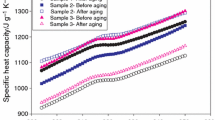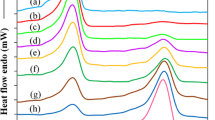Abstract
DSC curves of polyster/cotton blends indicate that the glass transition temperature,T g, of cotton varies with the blend composition. Standard curves for quality control purposes are presented and are based on either the cotton or PET transition peak areas. Factors that contribute to the size of the peak areas were determined: a composition coefficient factor and a thermal coefficient factor.
Résumé
Les courbes DSC des combinaisons polyester/coton indiquent que la température de transition vitreuseT g du coton varie avec la composition. On présente des courbes types pour le contrôle de la qualité d'après les surfaces des pics de transition du coton ou du PET. On a déterminé les facteurs qui influencent la dimension des surfaces des pics: l'un est en rapport avec la composition et l'autre avec le coefficient thermique.
Zusammenfassung
Die DSC-Kurven von Polyster/Baumwoll-Gemischen zeigen, dass die Glas-Übergangstemperatur (T g der Baumwolle sich mit der Zusammensetzung des Gemisches ändert. Standardkurven für Qualitätskontrollen werden gezeigt, welche auf den Übergangspeakflächen der Baumwolle oder des PETs beruhen. Die zur Grösse der Peakfläche beitragenden Faktoren wurden bestimmt: ein Zusammensetzungskoeffizient und ein thermischer Koeffizient.
Резюме
ДСК-кривые смесей пол иэфира и хлопка показ али, что температура пере хода Tg хлопка в стеклообраз ное состояние изменя ется с изменением состава с меси. Для качественно го контроля представле ны стандартные кривы е, которые определены на основе площади пиков хлопка или поли зфира. Установлены фа ктор состава и термически й фактор, определяющи е величину площади пик ов.
Similar content being viewed by others
References
J. S. David andD. K. Walter, Textile Res. J., 46 (1976) 246.
B. P. Iyer andK. R. K. Yer, J. Appl. Polymer Sci., 20 (1976) 591.
Instruction Handbook Model DSC-2 Differential Scanning Calorimeter, Perkin-Elmer Norwalk, Connecticut, U.S.A., 1976, Sections 3 and 4.
O. Okpe, M. Sc. Polymer Science and Technology, Ahmadu Bello University, Zaria, Nigeria, June 1980.
R. F. Landel, Trans. Soc. Rheology, 2 (1953) 53; J. Polymer Sci., A. 1 (1963) 527.
Author information
Authors and Affiliations
Rights and permissions
About this article
Cite this article
Basak, B., Okpe, O. & Ugbolue, S.C.O. Studies on poly(ethylene terephthalate)/cotton blends by differential scanning calorimetry. Journal of Thermal Analysis 21, 239–248 (1981). https://doi.org/10.1007/BF01914207
Received:
Issue Date:
DOI: https://doi.org/10.1007/BF01914207




